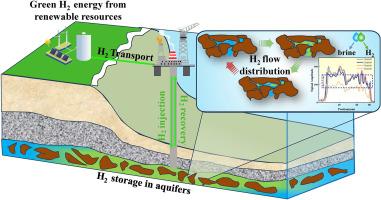Impact of displacement conditions on gas flow and recovery efficiency in hydrogen aquifer storage: Insights from NMR experiments
IF 8.3
2区 工程技术
Q1 CHEMISTRY, PHYSICAL
引用次数: 0
Abstract
Underground hydrogen storage (UHS) is a promising solution for large-scale and long-duration energy storage. However, pore-scale hydrogen displacement behavior in aquifers remains insufficiently characterized. This study leverages low-field nuclear magnetic resonance (NMR) to investigate multiphase flow dynamics using nitrogen (as a safer analog for hydrogen) and brine in a controlled injection–production experimental setup. We monitored real-time changes in transverse relaxation time (T2) distributions to semi-quantitatively evaluate the effects of confining pressure, flow rate, and displacement duration on fluid migration and recovery performance. The results show that macropores (T2 > 70 ms) primarily facilitated initial gas displacement, while small and medium pores (T2 ≤ 70 ms) became increasingly involved during brine re-imbibition. Despite varying confining pressures (up to 6.5 MPa), high flow rates (0.3 mL/min), and extended displacement periods (up to 10 PV), residual gas saturation remained, indicating that the recovery efficiency could not reach 100 %. The observed recovery behavior with pressure changes underscores the complex interplay between pore structure and displacement dynamics. These results suggest potential limitations in using nitrogen as a direct proxy for hydrogen in UHS, especially in scenarios where diffusion, dissolution, and interfacial effects are significant. A deeper understanding of the underlying mechanisms—such as interfacial properties and pore-scale sweep efficiency—remains necessary and requires support from quantitative measurements. While the current findings offer preliminary insights to guide the optimization of UHS operations through tailored injection parameters, they also underscore the need for more comprehensive studies involving direct hydrogen experimentation.

驱替条件对储氢层气体流动和采收率的影响:来自核磁共振实验的见解
地下储氢(UHS)是一种很有前途的大规模、长时间储能解决方案。然而,在含水层中,孔隙尺度的氢驱行为仍然没有得到充分的表征。本研究利用低场核磁共振(NMR)在可控的注采实验装置中,利用氮气(作为氢的安全模拟物)和盐水来研究多相流动动力学。我们实时监测横向松弛时间(T2)分布的变化,以半定量地评估围压、流量和驱替持续时间对流体运移和采收率的影响。结果表明,大孔隙(T2 > 70 ms)主要促进了初始气驱,而中小孔隙(T2≤70 ms)在盐水再渗过程中的作用越来越大。尽管围压(高达6.5 MPa)、流速(0.3 mL/min)和驱替周期(高达10 PV)变化很大,但残余气饱和度仍然存在,这表明采收率无法达到100%。观察到的随压力变化的采收率行为强调了孔隙结构和驱替动力学之间复杂的相互作用。这些结果表明,在UHS中使用氮作为氢的直接替代品可能存在局限性,特别是在扩散、溶解和界面效应显著的情况下。更深入地了解潜在的机制(如界面性质和孔隙尺度扫描效率)仍然是必要的,并且需要定量测量的支持。虽然目前的研究结果为通过定制注入参数来指导UHS操作的优化提供了初步的见解,但它们也强调了对直接氢气实验进行更全面研究的必要性。
本文章由计算机程序翻译,如有差异,请以英文原文为准。
求助全文
约1分钟内获得全文
求助全文
来源期刊

International Journal of Hydrogen Energy
工程技术-环境科学
CiteScore
13.50
自引率
25.00%
发文量
3502
审稿时长
60 days
期刊介绍:
The objective of the International Journal of Hydrogen Energy is to facilitate the exchange of new ideas, technological advancements, and research findings in the field of Hydrogen Energy among scientists and engineers worldwide. This journal showcases original research, both analytical and experimental, covering various aspects of Hydrogen Energy. These include production, storage, transmission, utilization, enabling technologies, environmental impact, economic considerations, and global perspectives on hydrogen and its carriers such as NH3, CH4, alcohols, etc.
The utilization aspect encompasses various methods such as thermochemical (combustion), photochemical, electrochemical (fuel cells), and nuclear conversion of hydrogen, hydrogen isotopes, and hydrogen carriers into thermal, mechanical, and electrical energies. The applications of these energies can be found in transportation (including aerospace), industrial, commercial, and residential sectors.
 求助内容:
求助内容: 应助结果提醒方式:
应助结果提醒方式:


